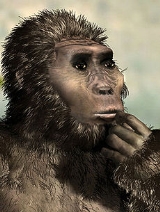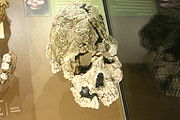
Kenyanthropus platyops
Encyclopedia
Kenyanthropus platyops is a 3.5 to 3.2 million year old (Pliocene
) hominin fossil that was discovered in Lake Turkana
, Kenya
in 1999 by Justus Erus, who was part of Meave Leakey
's team.
Leakey (2001) proposes that the fossil represents an entirely new hominine genus
, while others classify it as a separate species of Australopithecus
, Australopithecus platyops, and yet others interpret it as an individual of Australopithecus afarensis
.
 The fossil
The fossil
found features a broad flat face with a toe bone that suggests it probably walked upright. Teeth are intermediate
between typical human
and typical ape
forms. Kenyanthropus platyops, which means "Flat-faced man of Kenya" (a name given by Meave Leakey), is the only described species in the genus. However, if some paleoanthropologists are correct, Kenyanthropus may not even represent a valid taxon, as the specimen (KNM-WT 40000) is so distorted by matrix-filled cracks that meaningful morphological characteristics are next to impossible to assess with confidence. It may simply be a specimen of Australopithecus afarensis
, which is known from the same time period and geographic area, or its own species within Australopithicus, A. platyops. Other researchers speculate that the flatter face position of the rough cranium is similar to KNM ER 1470 (Homo rudolfensis
), and suspect it to be closer to the genus Homo
, perhaps being a direct ancestor. However the debate has not been concluded and the species remains an enigma.
The bones discovered at the site included more than 30 skull and tooth fragments in a stratum dated to between 3.5 and 3.2 million years ago.
Dr. Leakey believes that it belongs to an entirely new genus
of ancestors, and is the oldest "reasonably complete" cranium
found so far. Humans were once thought to have evolved only from Australopithecus afarensis, the species
made famous by the fossil Lucy
. But now it seems Lucy may have been sharing the woods and grass plains of prehistoric Africa with a rival.
When learning of the discovery, Daniel Lieberman, an anthropologist at George Washington University
expressed his opinion that between 3.5 and 2 million years ago there were several human-like species, each of which were well adapted to life in their particular environments. Also that, like that of many other mammalian groups, humans evolved through a series of complex radiations, known as "adaptive radiation".
The Kenyanthropus fossil has a small ear hole, like those of chimpanzee
s. It also shares many features of other primitive hominids, such as a small brain, but it also has striking differences, including high cheek bones, and a flat plane beneath its nose bone, which gives it a flat face.
Pliocene
The Pliocene Epoch is the period in the geologic timescale that extends from 5.332 million to 2.588 million years before present. It is the second and youngest epoch of the Neogene Period in the Cenozoic Era. The Pliocene follows the Miocene Epoch and is followed by the Pleistocene Epoch...
) hominin fossil that was discovered in Lake Turkana
Lake Turkana
Lake Turkana , formerly known as Lake Rudolf, is a lake in the Great Rift Valley in Kenya, with its far northern end crossing into Ethiopia. It is the world's largest permanent desert lake and the world's largest alkaline lake...
, Kenya
Kenya
Kenya , officially known as the Republic of Kenya, is a country in East Africa that lies on the equator, with the Indian Ocean to its south-east...
in 1999 by Justus Erus, who was part of Meave Leakey
Meave Leakey
Meave G. Leakey is together with her husband Richard Leakey one of the most renowned contemporary paleontologists. She studies the origin of mankind in Africa.-Flat-Faced Man of Kenya:...
's team.
Leakey (2001) proposes that the fossil represents an entirely new hominine genus
Genus
In biology, a genus is a low-level taxonomic rank used in the biological classification of living and fossil organisms, which is an example of definition by genus and differentia...
, while others classify it as a separate species of Australopithecus
Australopithecus
Australopithecus is a genus of hominids that is now extinct. From the evidence gathered by palaeontologists and archaeologists, it appears that the Australopithecus genus evolved in eastern Africa around 4 million years ago before spreading throughout the continent and eventually becoming extinct...
, Australopithecus platyops, and yet others interpret it as an individual of Australopithecus afarensis
Australopithecus afarensis
Australopithecus afarensis is an extinct hominid that lived between 3.9 and 2.9 million years ago. A. afarensis was slenderly built, like the younger Australopithecus africanus. It is thought that A...
.
Discovery and interpretations

Fossil
Fossils are the preserved remains or traces of animals , plants, and other organisms from the remote past...
found features a broad flat face with a toe bone that suggests it probably walked upright. Teeth are intermediate
Transitional fossil
A transitional fossil is any fossilized remains of a lifeform that exhibits characteristics of two distinct taxonomic groups. A transitional fossil is the fossil of an organism near the branching point where major individual lineages diverge...
between typical human
Human
Humans are the only living species in the Homo genus...
and typical ape
Ape
Apes are Old World anthropoid mammals, more specifically a clade of tailless catarrhine primates, belonging to the biological superfamily Hominoidea. The apes are native to Africa and South-east Asia, although in relatively recent times humans have spread all over the world...
forms. Kenyanthropus platyops, which means "Flat-faced man of Kenya" (a name given by Meave Leakey), is the only described species in the genus. However, if some paleoanthropologists are correct, Kenyanthropus may not even represent a valid taxon, as the specimen (KNM-WT 40000) is so distorted by matrix-filled cracks that meaningful morphological characteristics are next to impossible to assess with confidence. It may simply be a specimen of Australopithecus afarensis
Australopithecus afarensis
Australopithecus afarensis is an extinct hominid that lived between 3.9 and 2.9 million years ago. A. afarensis was slenderly built, like the younger Australopithecus africanus. It is thought that A...
, which is known from the same time period and geographic area, or its own species within Australopithicus, A. platyops. Other researchers speculate that the flatter face position of the rough cranium is similar to KNM ER 1470 (Homo rudolfensis
Homo rudolfensis
Homo rudolfensis is a fossil human species discovered by Bernard Ngeneo, a member of a team led by anthropologist Richard Leakey and zoologist Meave Leakey in 1972, at Koobi Fora on the east side of Lake Rudolf in Kenya. The scientific name Pithecanthropus rudolfensis was proposed in 1978 by V. P...
), and suspect it to be closer to the genus Homo
Homo (genus)
Homo is the genus that includes modern humans and species closely related to them. The genus is estimated to be about 2.3 to 2.4 million years old, evolving from australopithecine ancestors with the appearance of Homo habilis....
, perhaps being a direct ancestor. However the debate has not been concluded and the species remains an enigma.
The bones discovered at the site included more than 30 skull and tooth fragments in a stratum dated to between 3.5 and 3.2 million years ago.
Dr. Leakey believes that it belongs to an entirely new genus
Genus
In biology, a genus is a low-level taxonomic rank used in the biological classification of living and fossil organisms, which is an example of definition by genus and differentia...
of ancestors, and is the oldest "reasonably complete" cranium
Human skull
The human skull is a bony structure, skeleton, that is in the human head and which supports the structures of the face and forms a cavity for the brain.In humans, the adult skull is normally made up of 22 bones...
found so far. Humans were once thought to have evolved only from Australopithecus afarensis, the species
Species
In biology, a species is one of the basic units of biological classification and a taxonomic rank. A species is often defined as a group of organisms capable of interbreeding and producing fertile offspring. While in many cases this definition is adequate, more precise or differing measures are...
made famous by the fossil Lucy
Lucy (Australopithecus)
Lucy is the common name of AL 288-1, several hundred pieces of bone representing about 40% of the skeleton of an individual Australopithecus afarensis. The specimen was discovered in 1974 at Hadar in the Awash Valley of Ethiopia's Afar Depression. Lucy is estimated to have lived 3.2 million years...
. But now it seems Lucy may have been sharing the woods and grass plains of prehistoric Africa with a rival.
When learning of the discovery, Daniel Lieberman, an anthropologist at George Washington University
George Washington University
The George Washington University is a private, coeducational comprehensive university located in Washington, D.C. in the United States...
expressed his opinion that between 3.5 and 2 million years ago there were several human-like species, each of which were well adapted to life in their particular environments. Also that, like that of many other mammalian groups, humans evolved through a series of complex radiations, known as "adaptive radiation".
The Kenyanthropus fossil has a small ear hole, like those of chimpanzee
Chimpanzee
Chimpanzee, sometimes colloquially chimp, is the common name for the two extant species of ape in the genus Pan. The Congo River forms the boundary between the native habitat of the two species:...
s. It also shares many features of other primitive hominids, such as a small brain, but it also has striking differences, including high cheek bones, and a flat plane beneath its nose bone, which gives it a flat face.
See also
- List of fossil sites (with link directory)
- List of human evolution fossils (with images)

